
<< Back | Home | Site Map
The story of water in the mallee is deserving of a historical treatise in its own right. The railway engineers, for example, were an innovative breed. Providing a supply of water to remote stations and departmental residences following the opening of the railway was one responsibility. Another responsibility was to have suitable water supplies available for thirsty steam locomotives. Prior to the opening of the railway, the survey parties and construction gangs required an on-going provision of water to simply survive the remote mallee tract that was their task to conquer.
Construction trains and the first regular trains all carried a water tank or two to replenish supplies along the line and to guarantee a supply for the locomotive on the train. Stations with a permanent supply of water were Woomelang, Hattah and Mildura. A water supply at Minapre was not reliable.
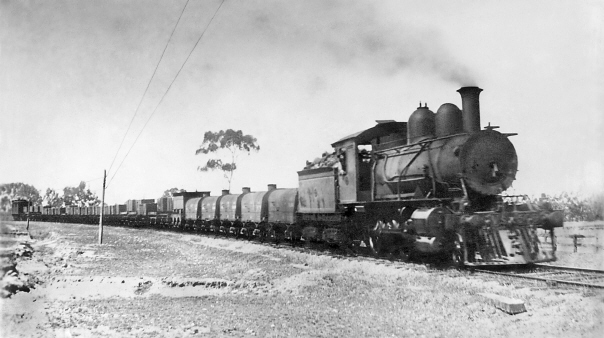
Locomotive V509 hauls a water train from Maryborough to stations on the Mildura line in 1902. Note the former locomotive tender used as a water tank in the consist of the train. Photo: J.C.M. Rolland Collection, Puffing Billy Preservation Society Archives
Austral Gypsum was an early exploiter of the natural gypsum deposits found throughout the mallee and it is recorded in 1906 that the Victorian Railways were forwarding water from Mildura to their siding located between Tempy and Bronzewing for the use of labourers. A typical profile for a mixed train on the Mildura line at this time was about 30 goods trucks, 7 water tanks, two passenger carriages and guards van.
The availability of fresh Murray River water at Hattah and Mildura provided a source of water during construction of the line and for stations as far away as Donald when opened for traffic.
In 1911 arrangements were made with the State Rivers and Water Supply Commission to provide water by rail to Speed, Tempy and Turriff and to sidings along the Ouyen to Murrayville during construction. A locomotive was based at Ouyen to run water trains from Hattah and in 1914 it was reported that trains from Mildura were taking up to 25 tanks of water a day for use further down the line.
A severe shortage of water occurred when the Ouyen town dam dried up in December 1914. Two 4,000 gallon water tanks were provided in the railway yards and were filled daily by a water train from Mildura. (A typical water train for Mallee destinations between Mildura and Woomelang and Ouyen and Murrayville, consisted of 35 wagons each with a capacity ranging from 800 to 2,400 gallons).
The dry conditions continued to cause problems with reports in February 1915 that water supplies at Bealiba, Cope Cope, St. Arnaud and Watchem were exhausted. Water was still available at Birchip and Woomelang, but was now unavailable from Hattah. Mildura's ample supply from the Murray River continued to sustain settlements and railway requirements. The dry weather caused practically all steam locomotives used in country districts to suffer from boiler problems. The corrosive effect of the mineralised water resulted in locomotives having their boiler tubes continually repaired.
By July 1915 the drought had eased but water was still being sent by rail from Mildura to Woomelang and along the Murrayville line. Three times a week, the Mixed train would take five tanks of 2,000 gallons each, with 4,000 gallons required for use between Mildura and Woomelang and 6,000 gallons for the branch line.
Drought conditions were recorded in the mallee in 1920 and it was reported in March that water trains were leaving Mildura daily for Ouyen and Tempy with and average load of 38,000 gallons. The water was for use by steam locomotives at Ouyen and by the State Rivers and Water Supply Commission to replenish water tanks.
The railway dam at Ouyen was dry by April 1921 and water from Mildura was being railed daily in two trains of 32 water trucks to supply the locomotive depot. Ten locomotives at Ouyen and eight at Woomelang required water at Ouyen in connection with wheat traffic working and another four locomotives from Mildura in general traffic also required replenishment of water at Ouyen. Up to 70,000 gallons of water was required each day. By May 1921, one train was bringing 54,000 gallons from Hattah and another, bringing a similar amount from Mildura for pouring into the Ouyen dam.
Water shortage became a problem again in March 1923 when water trains were required to run from Mildura every day to replenish four dams erected beside the railway at Kiamal. From 27-3-1923 to 27-4-1923, 2,343,000 gallons of water was taken from Mildura to Nyang (Torrita), Walpeup, Ouyen, Speed and Kiamal. Each water train comprised 27 trucks of 2,000 gallons. In addition, 7 trucks were forwarded to Nyang and Walpeup and 8 15-ton I trucks fitted with 2,000 gallon tanks were being sent out on the new line being built to Werrimull. The trains were often making two trips per day.
The District Superintendent, Ballarat submitted a report on the water position for engines, in response to a conference to consider the effects of a severe water shortage in 1939 due to low rainfall throughout the State. The report gave consideration to the curtailment of "those train services, the running of which would be dependent upon water supplies conveyed by rail". The following details were reported on 16-2-1939 for the Mildura line and mallee branch lines:
Ballan: Approximately two months supply. The Down Adelaide Express and the Down Mildura Passenger take water here.
Ballarat: The supply to householders for gardening is restricted, but the available reserve should last until next summer.
Creswick: Supply will last until the end of April; goods trains water as required.
Clunes: An ample supply of water, and will last for an indefinite period. Goods trains water here.
Maryborough: The existing supply will last for 3 or 4 weeks after which arrangements are being made for another source of supply, which is expected to be unlimited.
Bealiba: Supply exhausted.
St. Arnaud: Supply will last about three months; Passenger and Goods trains water here.
Donald: Expected that the supply will last until the end of June or July. Engine depot and a large quantity of water used for washing out (steam locomotive boilers), as well as for running.
Birchip: Will last till end of July. Engines of all Down and Up trains, including passenger, water here.
Woomelang: Supply will last until end of July. Nos. 65 and 48 goods and Nos. 32 and 36 Fast Goods water here.
Ouyen: The supply will last for 18 months: sub-depot, and very little washing out done.
Hattah: Supply run out.
Mildura: Ample water available.
Bambill: Only a small supply available.
Murrayville: Ample bore supply available.
The District Superintendent then went on to detail train services which could be curtailed on lines covered by this history:
Donald - Mildura: As water trucks would have to be hauled on the Donald - Ouyen section, the following trains could be cancelled:- No.31 Fast Goods from Melbourne to Mildura and Nos. 34 and 36 Fast Goods Mildura to Melbourne on Mondays and Wednesdays, and No.32 ex Ouyen to Donald and Melbourne on Tuesdays, Thursdays and Fridays. This would then leave Nos. 65 and 48 roadside goods trains to provide the goods service between Donald - Mildura.
Ouyen - Pinnaroo: The water supply at Ouyen and Murrayville would enable the existing service on this line to be maintained.
During construction of the Redcliffs to Werrimull railway in 1923, water trains were being forwarded daily from Mildura to the head of the line for the benefit of construction workers.
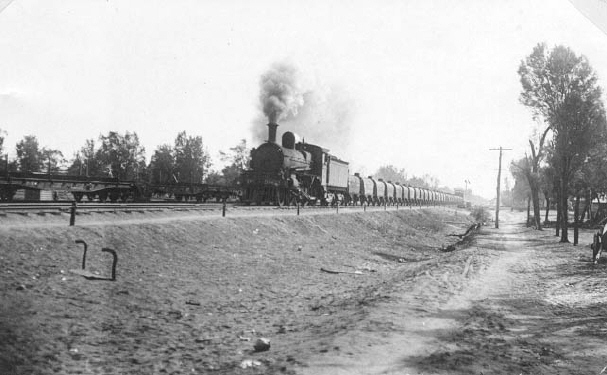
A DD Class locomotive arrives at Redcliffs with a train of 2,000 gallon water tank wagons. To the left of the locomotive is a rake of flat wagons for carrying rails, suggesting that the period is 1923 - 1931. Photo: Wilf Henty, courtesy John Kiely
The fresh water lakes at Hattah had dried by March 1931necessitating water trucks being attached to goods trains between Ouyen and Mildura. Stand-by water trucks were placed at Carwarp and Boonoonar sidings.
A company commenced mining gypsum along the Nowingi towards Millewa South line in January 1930 and in December 1932, another company started mining. Railway wagons were hauled along the line by a tractor-powered rail truck. Included in the load as required were rail tanks with water from the Murray River at Mildura - a regular provision until the closure of the Nowingi mining operation in 1988.
It was reported in February 1948 that two thousand gallons of water was being taken each day to Nowingi from Mildura for stock use.
The Victorian Railways doubled the size of its fleet of domestic water tank wagons at Mildura in late 1957 to 20, in preparation for a demand from mallee properties experiencing the effects of months of poor rainfall. The last time the railways were called on to assist with the distribution of water in large amounts was in 1944 when full trains of water trucks were sent to stations in the mallee. Some wagons in the fleet were of a new type with a capacity of 2,300 gallons, compared with 2,000 gallons in the old type.
The tank wagons were filled at Mildura from the locomotive depot water tank and during February 1958, more than 14,000 gallons had been railed to Ouyen and the Murrayville line.
Water was later being pumped from the Murray River near Mildura wharf siding.
Railway houses in the mallee and the Brunswick Plaster Mills gypsum mine, west of Nowingi, were supplied with water on a regular basis, and in July it was reported that a water train with six 2,000 gallon water tank wagons had been running each week for six months conveying water for stock and domestic purposes.
Drought conditions prevailed in the mallee during the 1967/68 summer. Water tankers (including converted former steam locomotive tenders) were being attached to goods from Mildura with supplies for Carwarp, Nowingi and Hattah stations and all stations between Ouyen and the South Australian border. Water was also supplied from Mildura to the Brunswick Plaster Mills and a grazing property along the privately operated Nowingi towards Millewa South line on a regular basis. It was reported in March 1968 that a farmer near Nowingi was receiving 5,000 gallons of water per week by rail.
Three sets of coupled former steam locomotive tenders with a capacity of 9,400 gallons of water in each pair and another six 2000 gallon water tank wagons were maintained at Mildura for this traffic.
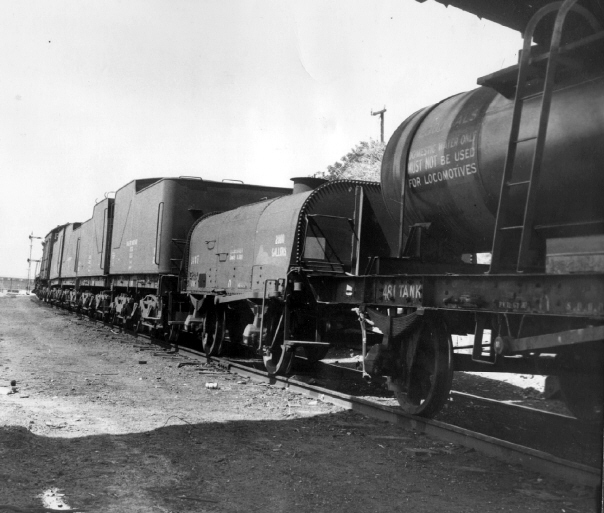
Water tank wagons being shunted at Mildura on 12-3-1968. Two pairs of former steam locomotive tenders, a 2,000 gallon WT wagon and 2,300 gallon tank wagon illustrate the variety of rolling stock allocated for water transport traffic to mallee destinations. Photo: Sunraysia Daily
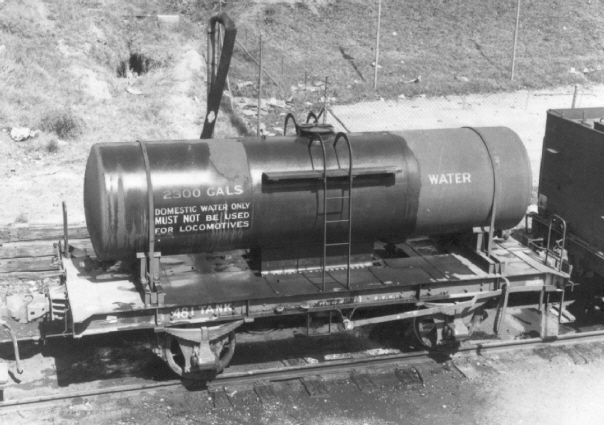
481 Tank has just been filled from the standpipe at the up end of Mildura station platform in readiness for another trip into the drought-stricken mallee. 12-3-1968. Photo: Sunraysia Daily
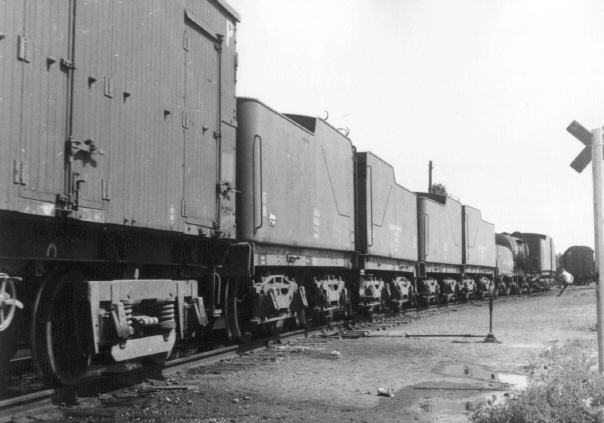
Former steam locomotive tenders have been converted to water tanks and are coupled in pairs. Here we see a variety of water wagons being shunted at Mildura on 12-3-1968. Photo: Sunraysia Daily
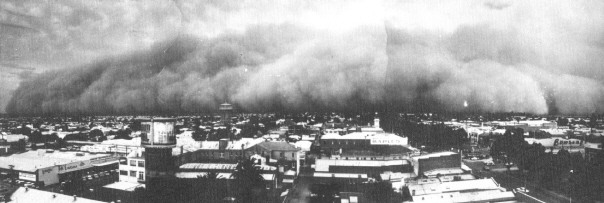
To illustrate the extent of the 1967/68 drought, this photo of a giant dust storm approaching Mildura on 24-2-1968 is included for interest. The author, who was employed by the Mildura television station STV8 at the time, accompanied "Sunraysia Daily" photographer Don Turvey part way up the television transmission tower in Deakin Avenue, Mildura whilst he hurriedly took a series of photographs to form this montage. The time was late afternoon, it was very hot, deathly quiet and the purple colored storm was approaching rapidly. We managed to reach the bottom of the tower as the storm engulfed us. Photo: Sunraysia Daily
Provision of water from Mildura continued to be an all-year round task for the railways maintaining supplies for departmental residences at Hattah, Nowingi and Carwarp as well as the Brunswick Plaster Mills gypsum mine.
Steam locomotive tenders used as water tankers (in coupled pairs) at Mildura on 28-8-1976 were WT206-207, WT208-209, WT210-211.
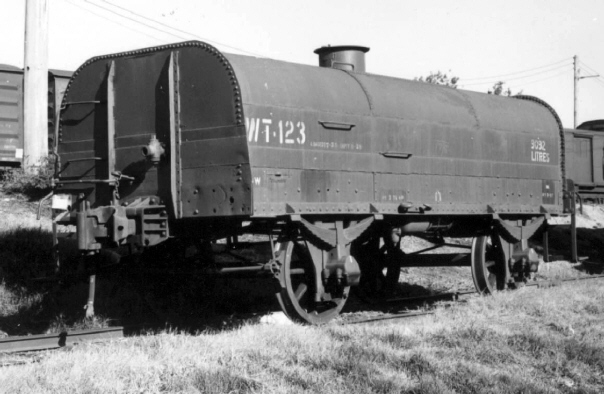
2000 gallon water tank WT123 at Mildura 27-8-1978. Photo: Bruce McLean
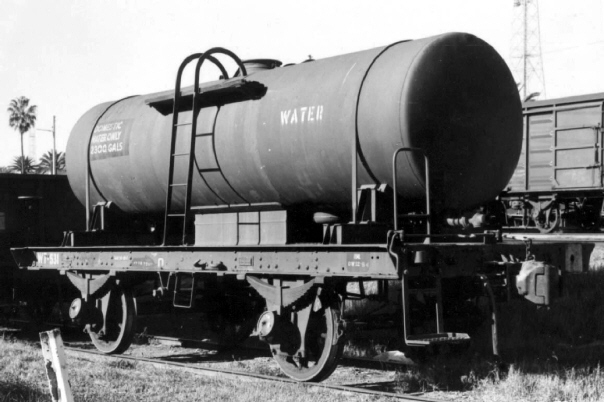
Domestic Water Tank WT531 with a capacity of 2,300 gallons at Mildura 27-8-1978. Photo: Bruce McLean
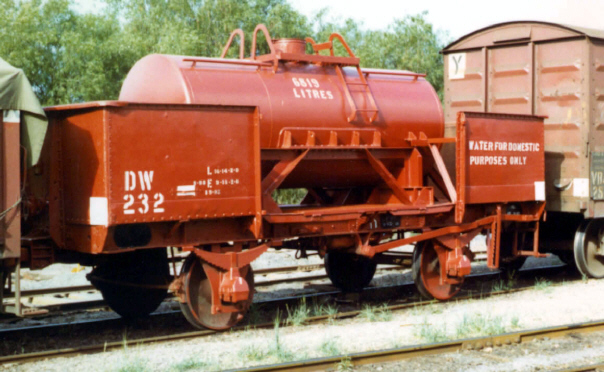
DW232 domestic water tank with a capacity of 2,300 gallons (6819 litres) at Mildura 3-10-1982. These tank wagons were introduced in 1961 and DW232 was regularly used until it was withdrawn from service, to provide water to the Brunswick Plaster Mills gypsum mine west of Nowingi. Photo: Bruce McLean
The closure of the gypsum mining operation at Nowingi and the withdrawal of fixed wheel rolling stock, together with a more commercially focused operation, saw the gradual demise of the railway as a means of water delivery. Road transport as usual stepped into this traffic.
| << Back | Home | Site Map | Copyright © 2003 Bruce McLean, All Rights Reserved |